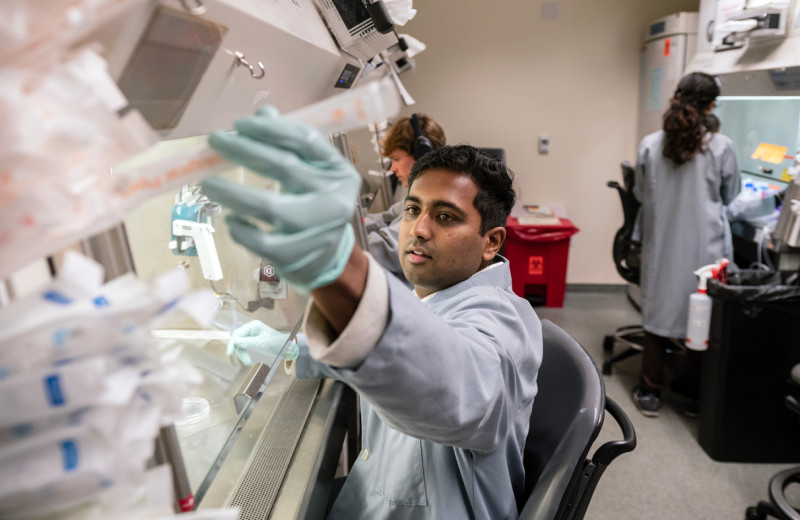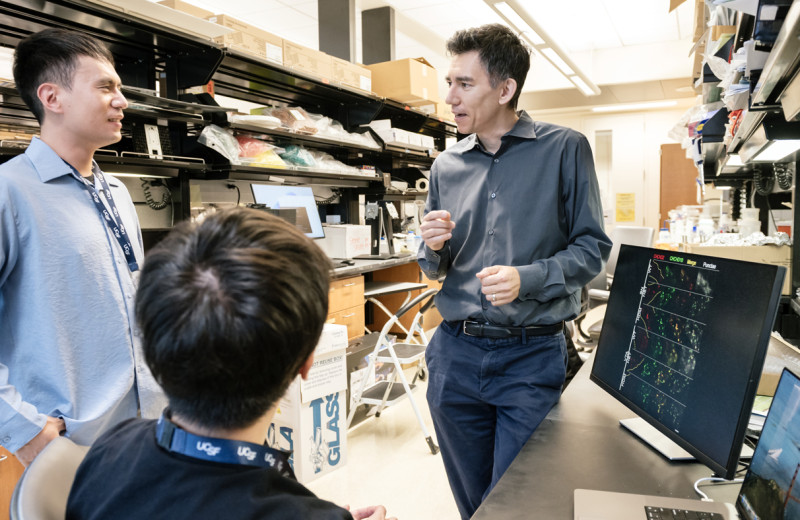Gladstone NOW: The Campaign Join Us on the Journey✕

Nevan Krogan (center) talks with his COVID-19 team. His network of scientists around the world have fast-tracked efforts to find the proteins in cells that get highjacked by COVID-19. (Photo: Susan Merrell)
An international team of more than 120 scientists has detailed the impact of 75 over-the-counter prescription and development-stage drug compounds on SARS-CoV-2, the virus that causes COVID-19. Several of these agents show promise in blocking SARS-CoV-2 replication in lab experiments. One compound investigated in the research, a common ingredient in over-the-counter cough medicines, appears to have the potential to promote the growth of the virus.
The collaborative study, published in Nature on April 30, 2020, was assembled and led by Nevan Krogan, PhD, a senior investigator at Gladstone Institutes and director of the Quantitative Biosciences Institute at UC San Francisco (UCSF). As the first hints of the pandemic emerged in January, over a matter of just a few weeks, Krogan formed a rapid-response research team of dozens of scientists and clinicians—hailing from Gladstone, UCSF, Icahn School of Medicine at Mount Sinai in New York, and Institut Pasteur in Paris—to search for potential treatments for COVID-19.
Rather than focusing on an antiviral approach to block SARS-CoV-2, the researchers first combined biological and computational techniques to create a “blueprint” of more than 300 human proteins that the virus requires to infect human cells and to thrive and replicate in the body. They then explored the question of which drugs, both those that are currently marketed as well as those in development, might be repurposed to treat SARS-CoV-2 infection by targeting those human proteins.
The researchers emphasize that, while the drugs identified in the study are promising, they have only been tested against the virus in lab experiments. The researchers do not advocate anyone prescribing and/or using the drugs unless human clinical trials find them to be safe and effective.
These findings were originally posted on bioRxiv in March 2020.
Repurposed Compounds Show Promise for Fighting COVID-19—Further Research Needed
Looking at a list of drugs that interact with the protein blueprint, UCSF researchers Brian Shoichet, PhD, professor of pharmaceutical chemistry, and Kevan Shokat, PhD, professor of cellular and molecular pharmacology and a Howard Hughes Medical Institute investigator, led studies employing chemical biology and computational approaches. Two drug categories emerged as promising agents to effectively reduce viral infectivity: protein translation inhibitors (including zotatifin and ternatin-4/plitidepsin), and drugs that modulate proteins inside the cell known as Sigma1 and Sigma2 receptors (including progesterone, PB28, PD-144418, hydroxychloroquine; the antipsychotic drugs haloperidol and cloperazine; siramesine, an antidepressant and anti-anxiety drug; and the antihistamines clemastine and cloperastine).
Among the protein translation inhibitors, the strongest antiviral effect in vitro was seen with zotatifin, which is currently in clinical trials for cancer, and ternatin-4/plitidepsin, which is FDA-approved for the treatment of multiple myeloma.
Among the Sigma1 and Sigma2 modulators, the antipsychotic haloperidol, used to treat schizophrenia, showed antiviral activity against SARS-CoV-2. Olanzapine, used to treat both schizophrenia and bipolar disorder, had no measurable effect on the virus. Two potent antihistamines, clemastine and cloperastine, displayed antiviral activity, as did PB28 and to a lesser extent the female hormone progesterone.
“While a large amount of COVID-19 therapeutic development research focuses on the antivirals and vaccines, we’ve taken a different approach, targeting the human counterparts and vulnerabilities required for viral infection in a human cell,” said Krogan. “Our work leverages approved and development-stage molecules and will help to focus clinical trials toward the most promising agents to combat COVID-19. We also continue to search for additional agents that target the human proteins used by SARS-CoV-2 to expand the armamentarium against the virus,” he said.
“While these are early data, we have a high degree of confidence in the results, since similar observations on the antiviral activity of these drugs arose from work done independently at both Mount Sinai and Institut Pasteur. Research at this speed and magnitude could only have been accomplished through a collaborative effort from several scientists at multiple institutions, each bringing unique but complementary skill sets toward a common research goal,” said Adolfo García-Sastre, PhD, professor in the Department of Microbiology and director of the Global Health and Emerging Pathogens Institute of the Icahn School of Medicine at Mount Sinai.
García-Sastre led the virological studies along with Marco Vignuzzi, PhD, principal investigator in the Viral Populations Unit at Institut Pasteur in Paris. Vignuzzi commented, “This study provides novel potential antiviral strategies that need to be explored, and it is unique in that it extends our knowledge on our basic understanding of how the virus interacts with the host.”
PB28 Shows Significantly Greater Antiviral Activity than Hydroxychloroquine
Among drugs targeting Sigma1 and Sigma2 receptors, a preclinical compound called PB28 had approximately 20 times greater antiviral activity in lab experiments than hydroxychloroquine, which is being studied as a potential therapy for COVID-19 in multiple clinical trials.
Theory for Cardiac Side Effects of Hydroxychloroquine
The new study presents a possible explanation for the serious cardiac side effects observed in some halted clinical studies of hydroxychloroquine. The researchers showed that, in addition to targeting the Sigma1 and -2 receptors, hydroxychloroquine also binds to a protein known as hERG, which is critical for regulating electrical activity in the heart. These lab findings may help explain the possible risks associated with this agent as a potential therapy for COVID-19.
Caution Urged for Dextromethorphan
Finally, the cough suppressant dextromethorphan, which acts on Sigma1 receptors, promoted viral infection in the lab experiments, and the researchers said that its use merits caution and warrants further study in the context of COVID-19.
Next Step: Testing Compounds in Animal and Human Clinical Studies for COVID-19
Krogan said the next step is to further investigate the most promising compounds to advance them as quickly as possible through clinical trials. “We are working with several pharma and biotech companies to evaluate the antiviral effectiveness and safety of drug candidates that showed the most promise in our lab experiments,” he said. “Conversely, because our research shows that dextromethorphan promotes SARS-CoV-2 infection in the lab, we urge that this compound be used prudently during the pandemic.”
Shokat added, “Our collaborative efforts have successfully mapped the proteins in the human body associated with SARS-CoV-2 infection, which has informed swift, science-based drug discovery. Uncovering the proteins targeted by this coronavirus has unveiled compounds across different drug classes that might have otherwise not have been obvious to study in a viral setting.”
Background on Innovative Scientific Approach
The researchers introduced the coronavirus proteins into human cells in culture. Once inside the cells, the viral proteins found specific human proteins that they could latch onto—very much as they would during a normal infection.
After identifying these proteins and determining small molecules known to bind them based on prior scientific research, the scientists identified 69 molecules that seemed most promising based on their targeting specificity.
Subsequently, the team assessed the impact of 47 of these compounds in cells infected with live virus, as well as an additional 28 compounds known to act on two key targets identified by other methods. These experiments were required to quickly establish robust and quantitative viral replication inhibition assays under high biocontainment to study the impact of these compounds on the biological cycle of the SARS-CoV-2 virus.
Aside from helping scientists quickly identify the most promising drug candidates to pursue, which may result in the initiation of new clinical trials, these results also provide broad insights into SARS-CoV-2 infection. Scientists can use this information to understand or anticipate the effect of experimental treatments already attempted in the clinic. Additionally, this novel approach for drug discovery can be leveraged across other viral and nonviral diseases.
Featured Experts
Support Our COVID-19 Research Efforts
Gladstone scientists are moving quickly to respond to the coronavirus outbreak. Help us end this pandemic.
Genomic Maps Untangle the Complex Roots of Disease
Genomic Maps Untangle the Complex Roots of Disease
Findings of the new study in Nature could streamline scientific discovery and accelerate drug development.
News Release Research (Publication) Marson Lab GenomicsThe Genome Editing Playbook Is Different in Neurons
The Genome Editing Playbook Is Different in Neurons
The striking findings of a new study could influence how gene therapies are designed for many genetic diseases.
News Release Research (Publication) Neurological Disease Conklin Lab Doudna Lab CRISPR/Gene EditingEvidence Builds for Disrupted Mitochondria as Cause of Parkinson’s
Evidence Builds for Disrupted Mitochondria as Cause of Parkinson’s
A new study from Gladstone Institutes strengthens the links between energy breakdown in cells and the onset of Parkinson’s, potentially illuminating new paths for treatment.
News Release Research (Publication) Parkinson’s Disease Neurological Disease Nakamura Lab




